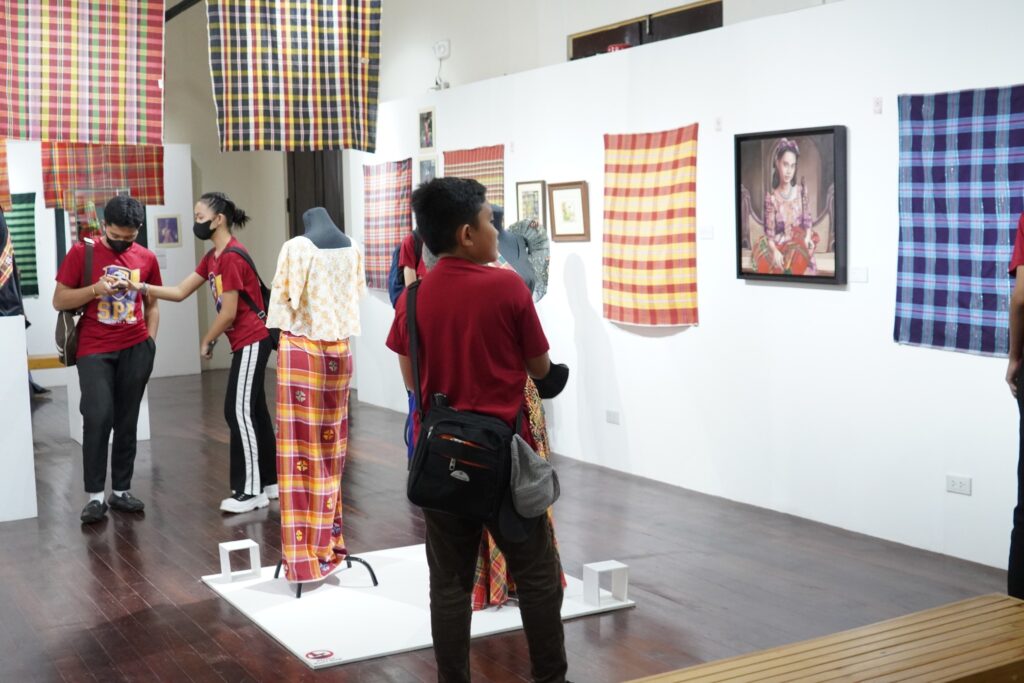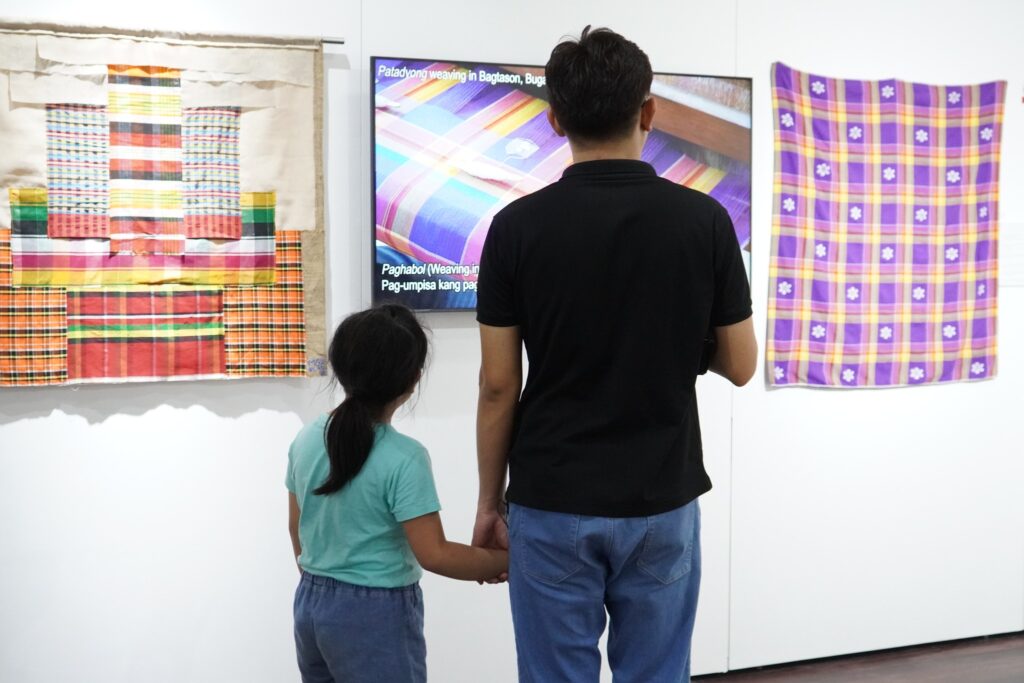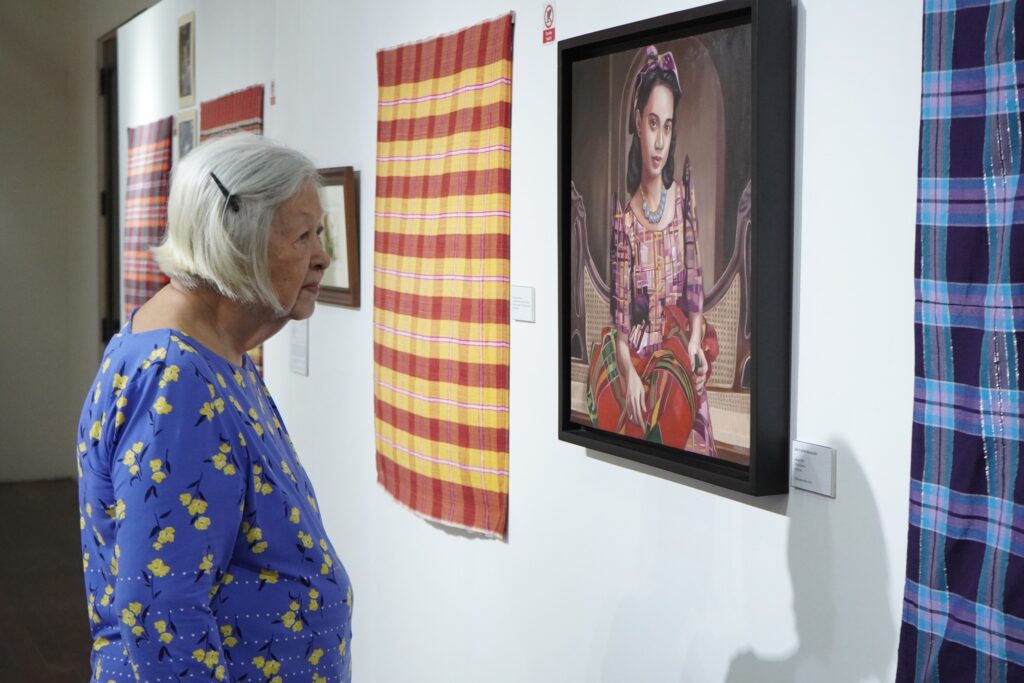I have two vivid childhood memories about patadyóngs. When I was in grade school I needed a patadyóng for a cultural performance. I’m no longer sure if it was a folk dance or a voice choir. I needed an ‘ethnic’ costume, which entails wearing black slacks and undershirt, with a patadyóng worn as a sash. My grandmother borrowed one from a friend, since she no longer has one. It had a cross-stripe red and white pattern. The second memory is when visiting a new born cousin, at that moment sleeping in a patadyóng made into an abuy-abuy tied from the ceiling of my aunt’s house. My aunt fondly shared that it was the exact same patadyóng she fell asleep in when she herself was baby. The exhibit NAÚG: Patadyóng as Art Form and Function is especially curious to me as it also similarly presents the fabric, usually made from native cotton (Gossypium hirsutum), through its binary roles. Curated by Martin Genodepa, Naúg (‘a Hiligaynon word that means ‘cloth’ or ‘clothing’) straightaway has the intention to overwhelm. The entire Lantip gallery of the UPV Museum of Arts and Cultural Heritage is filled with photographs, paintings, a monitor playing a short documentary on loop, actual patadyóng by themselves or in mannequins, and finally some dangling from the ceiling like banners. Naúg claims to showcase the twin roles of aesthetics and functionality, but ultimately prioritizes the former, choosing craft over history, and creating a consistent tone throughout the exhibit.
In broad strokes, the exhibition text discusses the etymological origins of patadyóng, variations of designs, and contextualizes the local production specifically in Iloilo and Antique. The text also briefly mentions links to other textile cultures in the country such as the malong, a term which I grew up hearing people use interchangeably with patadyóng but rarely explaining its Maranao roots. The historical starting point is the 19th century, ‘In the late Spanish period, weaving was a domestic enterprise done generally by women.’ There is however a noticeable jump in the said history outlined. ‘The towns of Miagao, Oton, and Badiangan in Iloilo, and Bugasong in Antique, figured prominently in patadyóng making. These were the centers for patadyóng weaving in Western Visayas. Today, these same towns are taking the lead in the resurgence of local textile weaving.’ This is worth unpacking since a ‘resurgence’ implies a decline of the industry which is obscured in the exhibit. This omission is glaring since a major thrust of the exhibit is to show the textile’s legitimacy and vibrancy, concluding that ‘The patadyóng can never, therefore, be dismissed as an old piece of rag, which is another meaning of the word naúg.’

Indeed by the 19th century, Iloilo had a considerable weaving industry. Aside from cotton, the main products are jusi, sinamay, and silk (Funtecha, 1985). These textiles were exported to different parts of the country and even abroad. A shift in the region’s economic make up can pinpointed in 1865, when Nicolas Loney was appointed as vice consul. The British entrepreneur didn’t only bring machinery that paved the way for sugar production in the region, but while serving as “a commercial agent for several foreign firms, he increased several times over the sale of cheaper English cotton goods, thereby destroying the local market for Iloilo’s textiles.ˮ (Funtecha, 1985, p. 111). This early globalization, with clear winners and losers, is rarely problematized in Iloilo City’s colonial modernity myth (opening to world trade, Queen City of the South, etc) where Loney figures dominantly, having a monument in the river wharf that still bears his name. This episode concisely locates the marginalization of the patadyóng to small scale artisanal production primarily serving a rural, indigenous, low-income, and female demographic. I remember in grade school my teacher simply said to ask our grandmothers if they still have their patadyóng, or something to that effect.
The photographs scattered in Naúg are a direct evidence of the relegation of the patadyóng. All of the photos present are from the archives of the Center for West Visayan Studies (CWVS) Collection, namely entries to the Duag Patadyóng 2004 Photo Contest. The photos either show the weaving of the patadyóng or the function it performs in many domestic but also agricultural tasks. In the former category, the spotlight is always the textile. Marichu S. Ruiz’ Habol shows the profile of a weaver’s upper body working on a loom while John Lester H. Santiago’s Mga Kamot nga may Kina-adman shows merely fingers. Genry Y. Arandela’s Sinulid at Karayom actually shows a elderly weaver’s face, the only close-up in all the pieces. Meanwhile Ma. Theresesa Q. Salazar’s Aboy-A-Boy! shows a toddler staring back on the camera while holding on to a patadyóng presumably with a younger sibling. Similarly Rheo Nepmuceno Mother and Child, is the only one showing an Ati mother breastfeeding with the infant wrapped inside a patadyóng. Consistently, the people in the photos are anonymous. Body parts appear to be extensions of the loom, as much as the fabric is foregrounded over the labors depicted. What is highlighted instead are the names of the the photographers standing-in as authors or artists. Considering the academic orientation of the CWVS, one can discern the documentation of a disappearing artifact as the logic of its archive, and the contest organized to build it. The only instances where weavers were identified, it is through the name of their cooperative, such as the Bagtason Loom Weavers Association in Busagong, Antique. Meanwhile the video played on loop from the facility of the said association, significantly feature young male weavers but ones that are still unnamed. All this suggests that weavers have to be an economic unit first and foremost, in order to be recognized in the patadyóng’s supply chain network. Meanwhile the other end of the economic transaction is seen in the heirloom gowns in mannequins, which bear the name of the owner or from whom it is on loan but not the designer or weaver. The dress worn, and later donated, by former tourism secretary Narzalina Lim designed by Patis Tesoro is an exception, most likely to the latter’s stature.

The patadyóng’s marginality is dialectically reflected on the older art works present in Naúg. These are practically miscellaneous works, based on their dimensions and mediums, of established artists where the patadyóng as a motif appears. Nunelucio Alvarado’s Dungganon sa Uma (1990, acrylic on handmade paper, 24x20cm) and Levi Salmon’s Pangarab (1985, mixed media, 15x19cm) both depict peasant women using patadyong as an apron or over-garment while working on the fields. Women’s faces are shown in Alvarado’s, while in Salmon, the peasant is bending down cutting rice stalks with a scythe with only her back visible. Manuel Baldemor’s Two Women (1976, etching 29x25cm) emphasizes the intricate patterns of the patadyóng, noticeably under the influence of the eventual move of the fabric being integrated into Filipiniana formal wear. The bilao on both their heads, appearing to contain leafy vegetables being peddled, suggests they also come from peasant backgrounds. Curiously, they are depicted as having blank white faces, like two-dimensional mannequins. In contrast, Nelson Ferraris’ Lab-asera (1984, mixed media, 41x28cm) showing a fish vendor does have a face, although one that looks away. Earlier depictions of the patadyóng in works selected oscillate between showing laboring women with dignity, or subtle eroticism, and even a combination of both. This continuity with the older paintings and photos, though decades apart, is an evidence of the perpetually fraught condition of peasants, though the patadyóng highlighted the role of women in the sector still commonly imagined to be purely masculine.
Instead of collecting miscellaneous pieces, giving off a feeling of scratching the bottom of a barrel, three new works take on the patadyóng as a starting point. Margaux Blas’ Tampi (2023) threats the fabric as a canvas by combining several conventional patadyóng patterns. These patches are not neatly woven in place exposing overlaps and strands. Aside from a few photographers, Blas happens to be the only woman artist featured, and her work is the one most comfortable with its materiality. The manner how Tampi constructs and deconstructs, is in conversation with the actual patadyóngs and clothes derived from them, the art works, and the photos. On the hand, Martin Genodepa’s Abuy-abuy (2023) is a deceptively simple installation, though the patadyóng cradle is probably the most potent signifier of the unity of form and function. The piece not only exemplifies the fabric’s strength but also people’s trust to its endurance and dependability in child rearing or care giving in general. Hanging from a bamboo pole standing in for a home’s ceiling beams, below the patadyóng are bricks. Between the bricks is a protruding knife, serving as a parallel to stories during World War Two of infants being impaled by Japanese soldiers. Though a generative addition to the piece, Abuy-abuy would have been fine by itself without the knife and the narrative it brings. Lastly, Kristoffer Brasileño’s Lin-ay (2023) reimagines classical portraiture featuring a young woman wearing a formal attire using patadyóng and its distinct designs. Still conventional in the sense that it shows someone from the affluent class, but subversive to the extent that it is ultimately a contrast to the voyeuristic gaze towards working class women’s bodies found in the older art works. I consider these three works as the Naúg’s focal point, though they are positioned in way that doesn’t present their dialogue with each other and with other pieces right away. The archive of older art works, and the dynamism of the new ones could have been an compelling exhibit by itself.

The works I have discussed so far are inserted, or even serve as footnotes, to the numerous patadyóngs spread out in walls. The concise indication that the exhibit chooses aesthetics over function are the multiple ‘do not touch’ signs in almost every fabric. This is odd especially since the photos and the documentary on loop lay bare the very the tactile manner of how a patadyóng is made, only for this experience to be withheld from visitors. In consideration to preserving the conditions of the fabrics, perhaps a few samples could have been provided for those who might be curious of its texture. By reducing the fabric into mere objects to gaze at, Naúg makes clear where it looks toward. The patadyóng’s ‘resurgence’ could only be through its conversion into an purely artisanal product, one that is accessible only to affluent locals and foreign tourists, and perhaps returning Filipino migrants, where it can be a convenient ‘ethnic’ symbol of leisure and privilege. This is antithetical the textile’s history and the people it owes its survival in the last century or so. This sentiment is reiterated in the section in the exhibit statement communicating optimism, the ‘patadyóng has been showcased in international shows by llonggo designers as beach bags, footwear, umbrellas, and costume textile-based jewelries.’
However, a quick survey in Iloilo City, or in any place in the country, would bring to light that people have more access to ukay-ukay, or pre-loved garments from affluent countries rather than the patadyóng, or any similar textile being converted into an artisanal product. This of course is a symptom of linked crises, of the high level of consumption abroad and the low purchasing power locally. There will be no resurgence without coming into terms that the country remains a dumping ground of surplus products, ushered in the 19th century by figures like Loney, that ultimately prevents the rise of local industries catering to the needs of local consumers. This economic dimension could have been integrated into the exhibit by adding brief testimonies from weavers for examples, especially on the inseparable concerns craft revival projects always bring: empowerment, financial security, community building, and creative autonomy. This is on top of discussions of concepts like fair trade and ethical supply networks which is presumably advocated by the various patadyóng cooperatives.
A key response to experiencing Naúg and how it overwhelms, is sharp attention to the histories and futures, and overlapping discourses it both presents and obscures. I consider the exhibit foremost as an impressive archive, one that already provides the seeds of solutions to the contradictions it explores. In trying to prove that the patadyóng is no longer to be ‘dismissed as an old piece of rag’, the exhibit runs the risk of the same textile to be dismissed as a status symbol of the conspicuous elite.
REFERENCES:
Funtecha, Henry F. 1992. THE MAKING OF A “QUEEN CITY”: THE CASE OF ILOILO 1890s-1930s.Philippine Quarterly of Culture and Society, Vol. 20, No. 2/3 (June/September 1992), pp. 107-132.
Photos from UP Visayas Office of Initiatives in Culture and the Arts